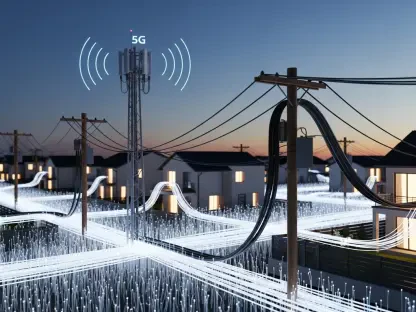In an era where seamless internet connectivity is no longer a luxury but a necessity for both homes and small businesses, the rapid evolution of wireless technology continues to redefine how users interact with the digital world. At the forefront of this transformation, a prominent player in networking solutions has unveiled groundbreaking products at a major tech event in Berlin this year. Their latest offerings promise to bring cutting-edge Wi-Fi 7 technology to a broader audience by tackling one of the biggest barriers: cost. With an impressive lineup of devices that balance high performance with affordability, this showcase signals a pivotal shift in making next-generation networking accessible to everyday consumers. From compact adapters to powerful routers, the innovations on display address common connectivity challenges while ensuring compatibility with older systems, setting a new standard for what users can expect from modern wireless solutions.
Unveiling Wi-Fi 7 Innovations
Breaking Down Barriers with New Adapters
At the heart of the latest product reveals is a compact USB adapter designed to upgrade Windows-based laptops and desktops to Wi-Fi 7 compatibility. This device, supporting tri-band wireless across 2.4GHz, 5GHz, and 6GHz frequencies, delivers remarkable speeds of up to 2.88 Gbit/s on the higher bands and 688 Mbit/s on the lower band. Its significance lies in providing an affordable entry point for users to tap into the capabilities of advanced routers without needing to replace existing hardware. Backward compatibility ensures that even older devices can integrate smoothly into modern networks, while features like easy setup through WPS and built-in vents for heat management during high-throughput usage guarantee reliability. This adapter represents a practical solution for those hesitant to invest in entirely new systems, effectively bridging the gap between legacy equipment and the latest wireless standards.
The impact of such a device extends beyond mere technical specifications, as it addresses a critical pain point in the adoption of Wi-Fi 7 technology. Many consumers face the challenge of device incompatibility, where older laptops or desktops cannot connect to newer, high-speed routers. By offering a cost-effective upgrade path, this adapter empowers users to experience faster and more stable connections without prohibitive expenses. Its design prioritizes user-friendliness, ensuring that even those with minimal technical expertise can enhance their setups. This focus on accessibility not only democratizes access to cutting-edge connectivity but also highlights a strategic effort to make advanced technology a feasible option for a wider demographic, from students to small business owners looking to optimize their digital environments.
Expanding Router Capabilities for Diverse Needs
Another highlight of the showcase is a high-end cable router that integrates tri-band Wi-Fi 7, a DOCSIS modem, and smart home functionalities through Zigbee and DECT support. Boasting aggregate speeds of up to 12 Gbit/s, alongside telephony and media features, this device caters to users seeking top-tier performance for demanding applications like 4K streaming and online gaming. Its comprehensive capabilities make it a standout choice for tech enthusiasts, yet the pricing remains competitive compared to similar offerings in the market. This balance of advanced features and affordability underscores a commitment to delivering value without compromising on quality, positioning it as a versatile solution for modern households with complex connectivity needs.
For those on tighter budgets, entry-level routers with Wi-Fi 7 support are also part of the lineup, tailored for DSL and fiber-optic users. These devices prioritize essential connectivity for home offices and streaming, ensuring that even cost-conscious consumers can benefit from the latest wireless advancements. Enhanced features cater to everyday tasks, making them ideal for small families or individuals who require reliable internet without the bells and whistles of premium models. The availability of such options reflects a nuanced understanding of diverse user requirements, offering a spectrum of products that range from high-performance to budget-friendly. This approach ensures that the benefits of faster, more efficient networking are not reserved solely for those with deep pockets but are within reach of a broader audience.
Enhancing Connectivity and Smart Home Solutions
Tackling Signal Dead Spots with Repeaters
Beyond routers and adapters, a range of repeaters and mesh solutions were introduced to address persistent connectivity issues like signal dead spots in homes with thick walls or extended areas such as garages and garden sheds. These products, utilizing Wi-Fi 6 or 7, include weather-resistant outdoor models and mesh Wi-Fi sets that provide a cost-effective alternative to full mesh networks. By extending coverage to challenging environments, these extenders ensure that users can enjoy consistent internet access throughout their properties. The focus on practicality and affordability makes these solutions particularly appealing to homeowners seeking to eliminate weak signal areas without undertaking expensive network overhauls.
The strategic design of these repeaters emphasizes ease of integration into existing setups, allowing users to expand their networks with minimal effort. Whether it’s a single repeater for a small apartment or a comprehensive mesh set for a larger home, the range caters to varying scales of need. This adaptability is crucial in an era where remote work and smart home devices demand uninterrupted connectivity across every corner of a space. Moreover, the competitive pricing of these extenders reinforces the overarching theme of accessibility, ensuring that robust internet coverage is not a privilege but a standard expectation. Such innovations highlight a dedication to solving real-world problems faced by everyday users, paving the way for more inclusive technology adoption.
Advancing Smart Home Integration
The event also spotlighted expansions in smart home offerings, including a new energy management plug and an updated operating system that enhances device integration through Zigbee and Matter protocols. These advancements facilitate a seamless ecosystem where users can control and monitor various home devices with greater efficiency. The updated software also improves mesh functionality, ensuring that smart home setups operate cohesively with networking equipment. This focus on interconnected systems reflects a broader vision of creating user-friendly environments where technology serves practical purposes, from energy conservation to streamlined device management.
Equally important is the emphasis on affordability within these smart home solutions, making them viable for a wide range of consumers. The integration of energy management features allows households to reduce utility costs while adopting sustainable practices, a growing concern in today’s tech landscape. By combining these tools with accessible pricing, the latest offerings ensure that smart home technology is not limited to early adopters or high-income brackets. This democratization of advanced features fosters greater adoption rates, encouraging more users to explore the benefits of interconnected living. Ultimately, these products demonstrated a forward-thinking approach at the Berlin event, setting a benchmark for how technology can enhance daily life without imposing financial burdens.









